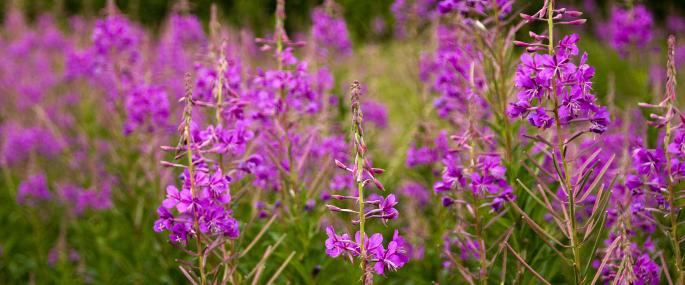Fennel
With feathery leaves and open umbrella-like clusters of yellow flowers, Fennel is a distinctive member of the carrot family (umbellifer). It favours grassy, disturbed ground and can be seen along roadside verges, and on waste grounds and sand dunes. Possibly introduced by the Romans as a herb for cooking and medicine, it is certainly widely naturalised today, and can be seen flowering between July and October.
Although they sometimes don't look especially wildlife-friendly, our roadside verges and waste grounds can provide valuable habitats for all kinds of plants and animals. The Wildlife Trusts get involved in different projects to help make these places as beneficial for wildlife as possible. We have a vision of a 'Living Landscape': a network of habitats and wildlife corridors across town and country, which are good for both wildlife and people. You can support this greener vision for the future by joining your local Wildlife Trust.
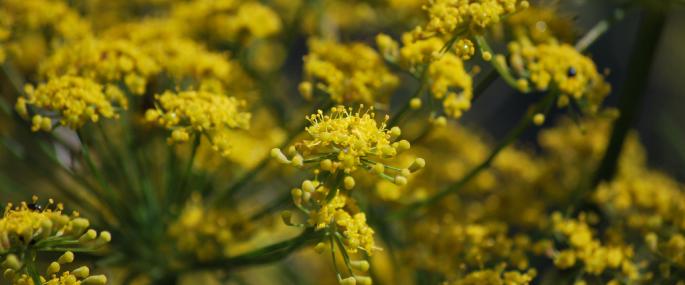
Ground-elder
Ground-elder was most probably introduced into the UK from continental Europe as a medicinal herb many years ago; it soon became established as a pernicious weed of gardens and cultivated ground. Compact umbels (umbrella-like clusters) of white flowers appear between June and August and are attractive to a range of insects.
Many of our so-called 'weeds' are beneficial to wildlife, providing food for nectar-loving insects and shelter for minibeasts. Try leaving wilder areas in your garden, such as patches of Ground-elder under a hedge, Red Clover in your lawn and Stinging Nettles near the compost heap, and see who comes to visit... To find out more about wildlife-friendly gardening, visit our Wild About Gardens website: a joint initiative with the RHS, there's plenty of facts and tips to get you started.
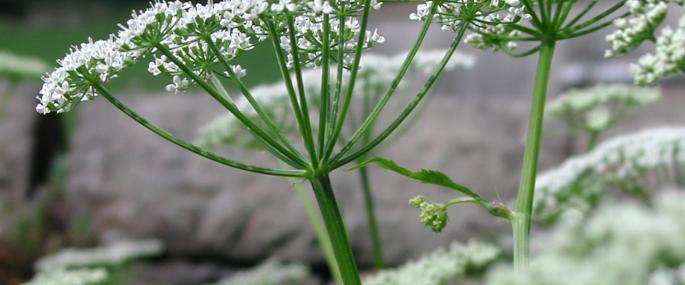
Pignut
Common in open woodland, hedgerows and dry grassland, Pignut is a small umbellifer (member of the carrot family) with fine leaves and delicate stems. Small umbels (umbrella-like clusters) of white flowers appear between April and June and are attractive to a range of insects such as soldier beetles and hoverflies.
The Wildlife Trusts manage many grassland nature reserves for the benefit of all kinds of wildlife. Careful grazing with traditional breeds, hay-cutting at the right time and scrub clearance are just some of the ways these fragile habitats are kept in good condition - supporting wildflowers like Pignut and, in turn, invertebrates and the larger animals that prey on them. By volunteering for your local Trust you can help too, and you'll make new friends and learn new skills along the way.
Hemlock
A notoriously poisonous plant, Hemlock features in history as the plant that was given to the famous Greek philosopher, Socrates, at his execution. But the repellent smell of the crushed leaves of Hemlock luckily helps to ensure that accidental poisonings don't occur very often - even livestock studiously avoid it. This biennial plant prefers damp ground and can grow in huge colonies on waste ground, riverbanks and ditches, but can also be seen along roadside verges. It produces umbels (umbrella-like clusters) of white flowers in June and July.
Our native wildflowers, such as Hemlock, provide important links in the food chain for many other animals, as well as areas for shelter and material for nesting. The Wildlife Trusts recognise the importance of healthy habitats to support all kinds of species throughout the food chain, so look after many nature reserves for the benefit of wildlife. You can help too: volunteer for your local Wildlife Trust and you could be involved in everything from coppicing to craft-making, stockwatching to surveying.
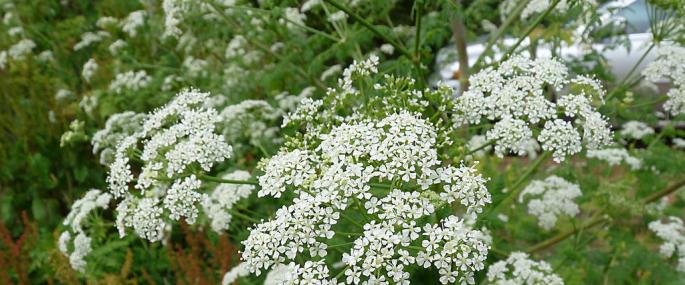
Cow Parsley
Cow Parsley is a hollow-stemmed, tall plant that grows rapidly in the summer before dying back. It likes shady habitats in particular, and can be found decorating woodland edges, roadside verges and hedgerows with masses of frothy, white flowers. These flower umbels (umbrella-like clusters) appear from May until June.
Our native wildflowers, such as Cow Parsley, provide important links in the food chain for many other animals, as well as areas for shelter and material for nesting. The Wildlife Trusts recognise the importance of healthy habitats to support all kinds of species throughout the food chain, so look after many nature reserves for the benefit of wildlife. You can help too: volunteer for your local Wildlife Trust and you could be involved in everything from coppicing to craft-making, stockwatching to surveying.
Sea-holly
Although more closely related to the carrot than true Holly, the spiky, grey leaves of Sea-holly ensure that this plant lives up to its name; they are covered with a waxy cuticle to help the plant retain water in the arid conditions in which it thrives. Found on coastlines and sand dunes (and even in gardens as a cultivated variety), Sea-holly blooms between July and September, producing round, teasel-like heads of striking blue flowers.
The Wildlife Trusts look after many coastal habitats for the benefit of all kinds of wildflowers, such as Sea-holly, and are working closely with farmers, landowners and developers to promote wildlife-friendly practices in these areas. We have a vision of a 'Living Landscape': a network of habitats and wildlife corridors across town and country, which are good for both wildlife and people. You can support this greener vision for the future by joining your local Wildlife Trust.
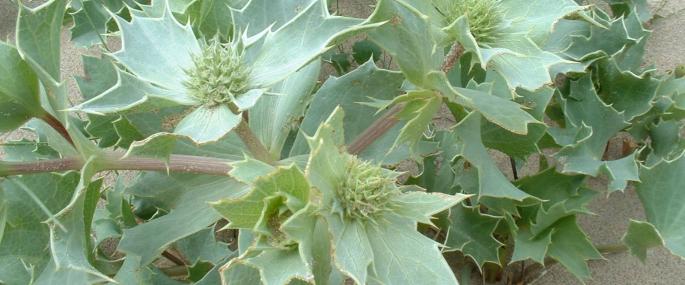
Spiked Water-milfoil
Spiked Water-milfoil is an aquatic plant, living submerged in slow-flowing streams and ditches, as well as lakes, ponds and flooded gravel pits. Its attractive, feathery leaves are held just below the surface of the water, but its tiny reddish flowers emerge on spikes during June and July. It provides shelter for many aquatic creatures and emergent stems offer places for dragonflies and damselflies to alight and lay their eggs.
Human activity, including the drainage of land for agriculture and development, has resulted in the disappearance of many of the UK's wetlands. The Wildlife Trusts are working closely with planners, developers and farmers to ensure our wetlands are protected. You can help too: add native plants and flowers to a wildlife-friendly pond and provide shelter for amphibians and nectar for insects. In particular, be careful to choose suitable plants and avoid invasive species, such as Parrot's Feather, which can spread to the countryside and cause problems for native wildlife, shading out plants and suffocating our waterways. In partnership with the RHS, The Wildlife Trusts' Wild About Gardens initiative can help you plan your wildlife garden.
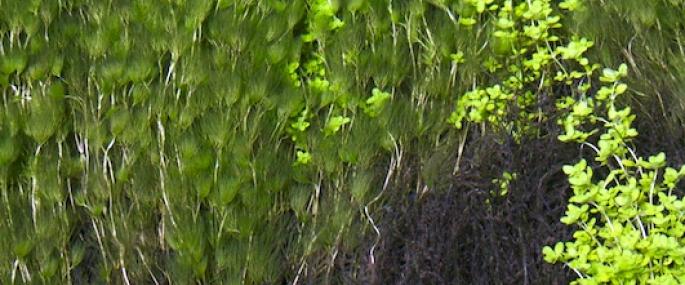
Ivy
The loss of many of our natural habitats in the countryside mean that the flowers and plants in our gardens provide vital food and shelter for a range of wildlife including butterflies, bees, birds and small mammals. To encourage wildlife into your garden, try planting native species such as Ivy. To find out more about wildlife-friendly gardening, visit our Wild About Gardens website: a joint initiative with the RHS, there's plenty of facts and tips to get you started.
Mistletoe
One of our most practised Christmas traditions - kissing under the Mistletoe - comes from Victorian times when a boy could win a kiss from a girl for each Mistletoe berry he picked from his bunch. This game probably originated from a Norse legend in which the goddess Frigga declared Mistletoe a symbol of love. Floating in lifeless trees, growing from thin air… it’s easy to see how people thought Mistletoe was magical.
With the massive decline in traditional orchards over the past 60 years, Mistletoe has become rarer, struggling to find a foothold in its favoured areas. The Wildlife Trusts are working with other organisations on projects to help conserve our orchards and the wildlife they support; for example, many local Trusts look after traditional orchards, or are cultivating orchards, on working farm nature reserves. You can help Mistletoe to spread by growing it in your own garden - extract the seeds and sticky juice from the berries of a cutting and wipe them on a young branch of a suitable tree such as an apple. To find out more about gardening for wildlife visit our Wild About Gardens website.
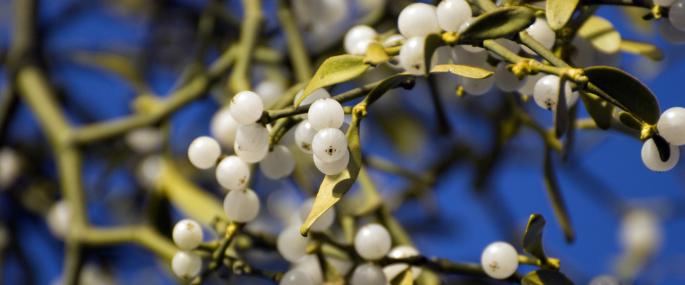
Rosebay Willowherb
The tall, pink flower spikes of Rosebay Willowherb can often be seen crowding together in thick stands in open spaces such as woodland clearings, roadside verges, grassland and waste ground. A successful coloniser, Rosebay Willowherb has grown in number from a scarce woodland plant to a ubiquitous flower. This expansion occurred as a result of two World Wars clearing huge areas of forest and burning the ground in both town and countryside - just the right conditions for this plant to thrive in. One of its common names in the south-east alludes to this takeover: 'Bombweed'.
Although they sometimes don't look especially wildlife-friendly, our roadside verges, railway cuttings and waste grounds can provide valuable habitats for all kinds of plants and animals from Rosebay Willowherb to Wood Mice. The Wildlife Trusts get involved in different projects to help make these places as beneficial for wildlife as possible. We have a vision of a 'Living Landscape': a network of habitats and wildlife corridors across town and country, which are good for both wildlife and people. You can support this greener vision for the future by joining your local Wildlife Trust.
